Marsfield, New South Wales
Marsfield is a suburb in Northern Sydney, New South Wales, Australia. Marsfield is located 16 kilometres north-west of the Sydney central business district in the local government area of the City of Ryde. Marsfield is often referred to as part of the North Shore.
| Marsfield Sydney, New South Wales | |||||||||||||||
|---|---|---|---|---|---|---|---|---|---|---|---|---|---|---|---|
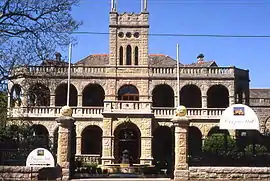 Curzon Hall on Agincourt Road, built in 1898 | |||||||||||||||
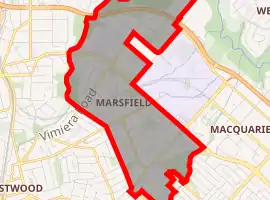
| |||||||||||||||
| Population | 13,297 (2016 census)[1] | ||||||||||||||
| • Density | 3,445/km2 (8,922/sq mi) | ||||||||||||||
| Postcode(s) | 2122 | ||||||||||||||
| Area | 3.86 km2 (1.5 sq mi) | ||||||||||||||
| Location | 16 km (10 mi) north-west of Sydney CBD | ||||||||||||||
| LGA(s) | City of Ryde | ||||||||||||||
| State electorate(s) | Ryde | ||||||||||||||
| Federal Division(s) | Bennelong | ||||||||||||||
| |||||||||||||||
The suburb is noted for its proximity to a number of leading scientific and tertiary educational institutions such as CSIRO, Macquarie University, the Macquarie Park Business Park and Macquarie University Hospital.
History
The suburb's name is derived from Field of Mars, the original name in the early days of British colonisation of Australia,[2] given to the area by Governor Phillip in 1792.
Aboriginal culture
The whole area between the Parramatta and Lane Cove Rivers was originally known by its Aboriginal name Wallumatta. The aboriginal name survives in a local park, the Wallumatta Nature Reserve, located at the corner of Twin and Cressy Roads, North Ryde.
European settlement
In 1792 Governor Phillip began the granting of parcels of lands to Royal Marines, and the area was referred to on Phillip's maps as the Field of Mars, named after the Roman Field of Mars probably because of the military link. The area was later part of the suburb of North Ryde, and many consider that Marsfield is still a part of the greater North Ryde area. Field of Mars was also the name for the parish proclaimed in 1835.[2]
In 1874, following extensive debate including a Parliamentary Select Committee, the government resumed the Common for sale and settlement by small farmers, using the money to fund bridges across the Parramatta River at Gladesville and Iron Cove. The land was subdivided into small farms of between 0.4 and 1.6 ha (1–4 acres), and released for sale in stages, starting in 1885.[3]
Many of the streets in Marsfield and bordering suburbs, mainly Eastwood and Macquarie Park, are named after famous historical conflicts or battles, such as Abuklea Road, Agincourt Road, Alma Road, Balaclava Road, Bannockburn Road (West Pymble), Buffalo Road (Gladesville), Busaco Road, Corunna Road, Cressy Road (East Ryde), Crimea Road, Culloden Road, Fontenoy Road, Khartoum Road, Plassey Road, Talavera Road, Taranto Road, Torrington Road, Trafalgar Place, Vimiera Road, Waterloo Road.
In 1894, the "Municipality of Marsfield" formed its own local government, splitting from Ryde Municipality.[3]
Stately, historical Curzon Hall was built in the 1890s by Harry Smith and named after his wife Isabella Curzon-Smith. The house was bought in 1921 by the Society of Saint Vincent de Paul which established St Joseph's Seminary on the premises.[4] It now serves as a function centre.
Until the 1950s, substantial parts of the North Ryde/Marsfield area were part of the "Green Belt" which prevented building houses on lots of less than 2 ha (5 acres). The Marsfield-North Ryde Green Belt boundaries were revised and in December 1959, 688 ha (1,700 acres) of land was rezoned. The last Green Belt land was released in September 1969 to build Macquarie Shopping Centre and Macquarie University.[3]
Boundaries
Marsfield is bounded by the Lane Cove River, Macquarie University Sports Fields, Talavera Road, Culloden Road, Waterloo Road, Vimiera Road, Marsfield Park and Culloden Road in the north, Epping Road, Shrimptons Creek, Kent Road, Ruse Street and Shrimptons Creek in the east, Bridge Road and Abuklea Road in the south and Terrys Creek in the west.
Landmarks and institutions
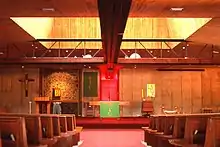
Marsfield is home to:
- Curzon Hall, 53 Agincourt Rd (built 1898 by businessman Harry Smith), a large castle-like manor in neo-Romanesque style, now turned restaurant/function centre[3]
- Professor Henry's House - the childhood home of one of the most prolific medical professionals of the modern age.
- St Anthony's Catholic Church, 54 Agincourt Rd - a Modernist/Brutalist church building designed by Italian architect Enrico Taglietti (1968).
- Epping Boys High School;
- Commonwealth Scientific and Industrial Research Organisation (CSIRO).
- Radio Physics Laboratory.
- Data61: Information Communication Technology (ICT) Centre, and
- Headquarters for the
Housing
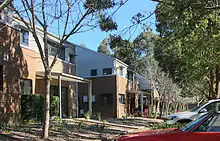
This green suburb features large, modern homes on the higher parts with views, and townhouses/units in the parts of the suburb that border South Turramurra and Epping. A large number of the residents are students of Macquarie University.
At the 2016 census, 45.6% of occupied private dwellings were semi-detached (townhouses etc.), 32.2% were separate houses and 21.0% were flats, units or apartments. 64.0% were family households, 26.6% were single person households and 9.5% were group households. The average household size was 2.6 people. The tenure was split between 38.7% of properties that were rented, 29.3% owned outright and 26.1% owned with a mortgage.[1]
Public Transport
A number of bus routes service Marsfield. The 292/293 routes run from the city through Lane Cove and terminate in Busaco Road while many other routes e.g. 288/291 travel along Epping Road to Epping station.
Macquarie University railway station is located on Herring Road between the university and Macquarie shopping centre.
Demographics
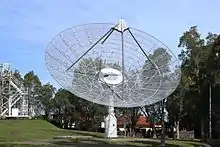
At the 2016 census, Marsfield recorded a population of 13,297. Of these:[1]
- Age distribution
- The residents of Marsfield were slightly younger than the country as a whole, with fewer children. Marsfield residents' median age was 35 years, compared to the national median of 38. Children aged 0–14 years made up 13.8% of the population (national average is 18.7%) and people aged 65 years and over made up 17.4% of the population (national average is 15.8%).
- Ethnic diversity
- 39.0% of people were born in Australia. The most common non-Australian countries of birth were China 20.1%, Hong Kong 3.7%, India 3.1%, South Korea 3.0% and Indonesia 1.9%. However, only 12.1% identify their ethnic ancestry as Australian; the other common self-identified ancestries were Chinese 28.7%, English 13.5%, Irish 4.8% and Italian 4.0%. 40.6% of people only spoke English at home. Other languages spoken at home included Mandarin 20.1%, Cantonese 9.3%, Korean 3.6%, Italian 2.0% and Indonesian 1.7%.
- Religion
- The most common responses for religion were No Religion 36.7% and Catholic 20.5%.
- Income
- The median weekly household income was $1,641, somewhat above the national median of $1,438.
References
- Australian Bureau of Statistics (27 June 2017). "Marsfield (State Suburb)". 2016 Census QuickStats. Retrieved 3 September 2017.

- Phippen, Angela (2008). "Marsfield". Dictionary of Sydney. Dictionary of Sydney Trust. Retrieved 21 September 2014.
- "Curzon Hall - Federation free style mansion". www.environment.nsw.gov.au. NSW Office of Environment & Heritage. Retrieved 11 September 2016.
- The Book of Sydney Suburbs, Frances Pollon, Angus and Robertson, 1990
External links
 Media related to Marsfield, New South Wales at Wikimedia Commons
Media related to Marsfield, New South Wales at Wikimedia Commons